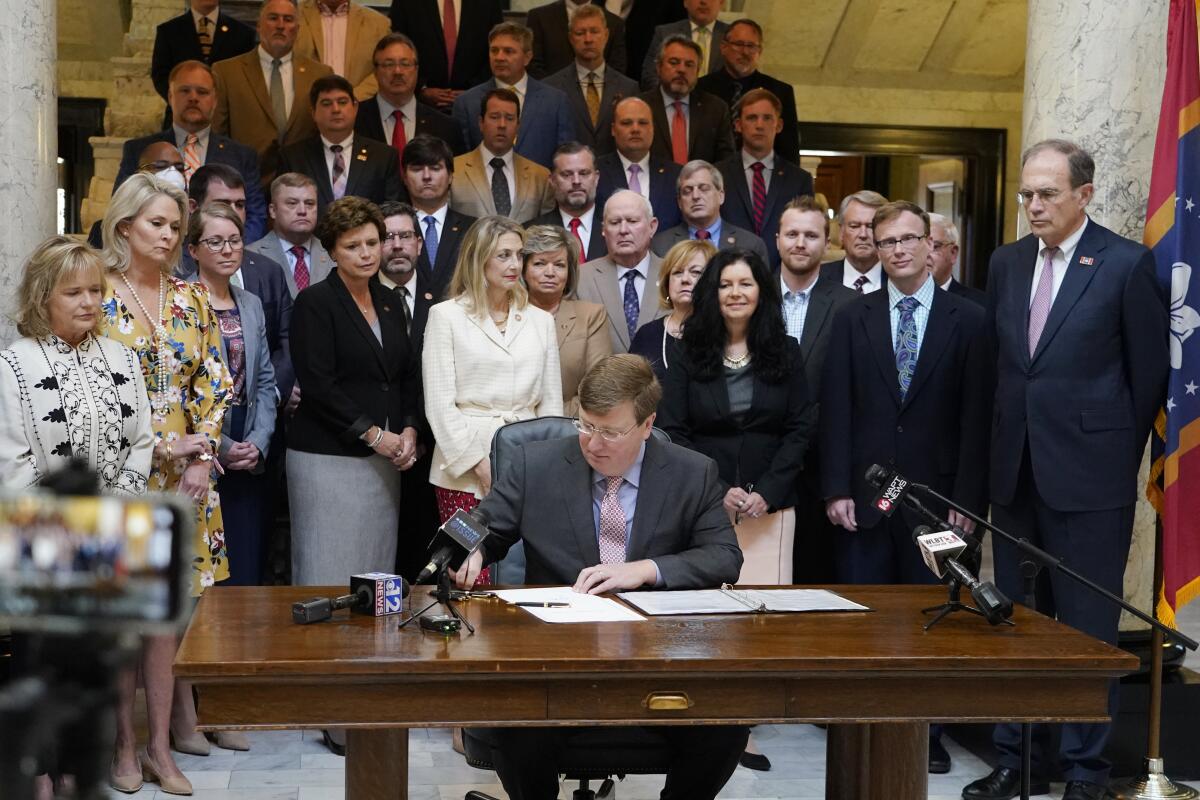Fear mongering around sports conceals discrimination against the trans community

- Share via
It’s only halfway through the year, but state lawmakers across the nation have already proposed a record-breaking number of anti-trans laws. Many of these laws seek to restrict transgender youth from accessing gender-affirming medical care and participating in sports.
In response, the California Department of Justice has added five states with anti-LGBTQ laws to the list of places where state employees cannot travel at taxpayer expense. Since 2017, the list has grown to 17 states.
Public support for the transgender community has increased since the Supreme Court guaranteed marriage equality in Obergefell vs. Hodges in 2015, but transphobic arguments persist because they prey upon people’s worst fears. In a video that went viral in June, a woman at Wi Spa in Los Angeles recorded her reaction and berated the staff after she claimed to have seen “a man go into the women’s section [and] show his penis.” Protesters clashed in the streets, two people were stabbed and conservative pundits wrung their hands over the prospect of women and children being preyed upon by men who could pose as transgender women.
How many times have we heard this harmful and baseless trope about the transgender community? It echoes the same type of abuse that was hurled at gay men in the 1950s when people accused them of pedophilia.
Activists continue to say that transgender athletes will decimate women’s sports, a wild and outrageous claim. In reality, transgender people make up only 0.6% of the U.S. population, and there’s no indication that they’re going to be overtaking elite sports any time soon. Transgender athletes have been allowed to compete in the Olympics since 2004, but this is the first year that we’ve had “out” transgender and nonbinary Olympians.
Granted, the science is contested as to whether transgender women athletes have a performance advantage. Research indicates that taking hormone suppressants doesn’t remove all the biological advantages of muscle mass and bone density, but lower testosterone also reduces oxygen capacity, which impacts an athlete’s endurance.
Dr. Eric Vilain, the director for the Center of Genetic Medicine Research at Children’s National Hospital, has served as an advisor to the International Olympic Committee Medical Commission and played an integral role in helping the NCAA craft its policies on transgender athletes. He’s been public about his view that the new laws preventing transgender athletes from competing are not based on science.
It’s an oversimplification to say that transgender athletes are dominating cisgender ones, Vilain said, for a simple reason: “Sports is inherently unfair. Elite sports are all about advantages that come from so many parameters. For trans women athletes, exposure to testosterone has not been shown to provide an overwhelming advantage in most events.” Vilain said we look at Usain Bolt or LeBron James’ natural physiology and say they’re talented or gifted, and the advantages that transgender athletes may have are no different.
Laws and policies that restrict the participation of transgender women police all women’s bodies, said Kathryn J. Perkins, an assistant professor of political science at Cal State Long Beach who specializes in LGBTQ politics. Perkins says that anti-transgender policies are colored with racism and misogyny; transphobia begins to rear itself in anti-Blackness and sexist ideas about how women’s bodies should appear.
The NCAA and the International Olympic Committee have policies that set standards for testosterone levels in transgender athletes. In some cases, these regulations have also affected cisgender athletes. The most famous example is Caster Semenya, a South African female middle-distance runner born with XY chromosomes and high levels of natural testosterone, who was barred from competing in her best events at the Olympics. This year, two runners from Nambia were banned from competing in the 400-meter event at the Olympics. “[These regulations] are reinforcing essentialist gender binaries,” said Perkins. “It’s based on the idea that men’s and women’s bodies are opposite and non-overlapping and women’s bodies are weak and fragile and that they can’t compete in sports with tough men’s bodies.”
Meanwhile, the public debate mistakenly conflates elite sports with school-age children. New laws in Arkansas and Mississippi and one being proposed in Florida target transgender youth in primary and secondary education. These laws claim to be rooted in fairness, but they’re only fueling antagonism toward the transgender community, which has been targeted with increasing violence. This year, the Human Rights Campaign recorded at least 31 transgender and gender nonconforming people who were victims of homicide, putting 2021 on track to exceed last year’s record total of 44 transgender people killed. A disproportionate number of these individuals were Black transgender women.
The lack of social acceptance is also one of the biggest factors affecting rates of suicide. Shelby Chestnut, the director of policy and programming at the Transgender Law Center, says that’s why the accurate and positive representation of transgender people is so important. “If you’re hearing negative messages about your entire existence, your rates of depression increase. Unfortunately the rates of suicide increase,” Chestnut said of at-risk transgender youth.
For athletes like Schuyler Bailar, being open about his journey is about hope. “I didn’t see anybody like me,” Bailar said of being a transgender Asian American man. Bailar made literal and metaphorical waves as the first transgender athlete to compete in Division 1 sports as part of the Harvard men’s swimming team. His social media presence has grown with his public activism; he shares infographics with over 300,000 followers aiming to affirm other transgender youth. “Now if you Googled transgender swimmer I pop up,” said Bailar. “[It tells kids] ‘Hey you belong here.’”
At the end of the day, the semantic debates and the politicization around transgender rights often erase the individuals — the kids who aren’t trying to compete for the Olympics, who just want to have fun. Let transgender kids be kids, and let them play on the teams they choose.
More to Read
A cure for the common opinion
Get thought-provoking perspectives with our weekly newsletter.
You may occasionally receive promotional content from the Los Angeles Times.










